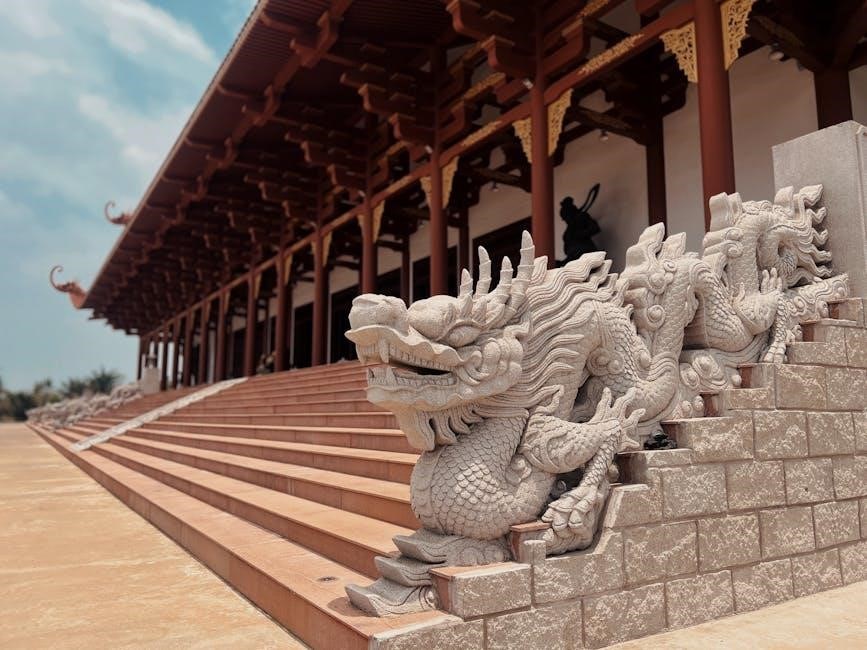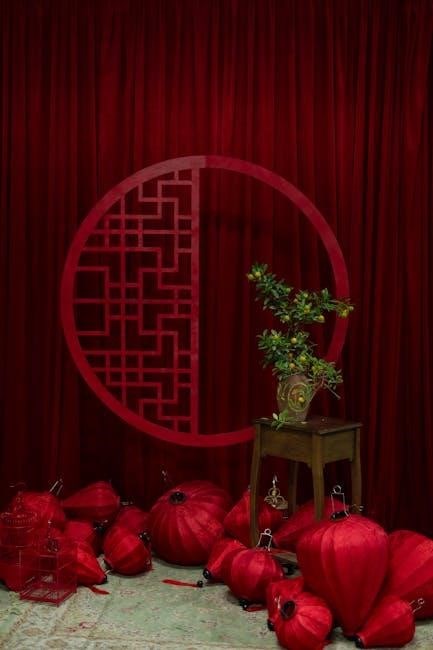Cross stitch symbols are essential for guiding stitchers through patterns. They appear on charts‚ representing specific stitches and colors‚ ensuring precise fabric and thread placement.
1;1 Importance of Symbols in Cross Stitch
Cross stitch symbols are the cornerstone of pattern interpretation. They serve as a visual language‚ guiding stitchers through complex designs. Each symbol represents a specific stitch or color‚ ensuring precision and accuracy. By following these symbols‚ crafters can bring designs to life‚ maintaining the intended aesthetic. They eliminate guesswork‚ making the craft accessible to both beginners and experienced stitchers. Their standardized use ensures consistency across patterns‚ fostering creativity and enjoyment in the stitching process.
1.2 Brief Overview of Common Symbols
In cross stitch‚ symbols are standardized for clarity. The most common include the full cross stitch‚ represented by an “X‚” and the half stitch‚ shown as a diagonal line. Backstitches are depicted as straight or curved lines‚ while specialty stitches like French knots are indicated by small circles. These symbols are universally recognized‚ ensuring consistency and ease of use for stitchers of all skill levels‚ from beginners to experts.
Understanding the Chart
A cross stitch chart is a visual grid representing your design. Symbols and colors guide stitch placement‚ ensuring accuracy. The chart maps directly to fabric‚ helping you align stitches precisely for a flawless finish.
2.1 How to Read a Cross Stitch Chart
A cross stitch chart is a grid-based design where each symbol corresponds to a specific stitch or color. The chart mirrors the fabric layout‚ with each square representing a stitch. Symbols are decoded using the color key‚ which matches them to thread colors. Start by locating the center mark on the chart and align it with the fabric’s center. Follow the grid row by row‚ translating symbols into stitches to replicate the design accurately.
2.2 Comparing the Chart to the Fabric
Each square on the chart corresponds to a stitch on the fabric. Use the center mark on the chart to align with the fabric’s midpoint. The symbols guide thread color selection‚ while the grid ensures accurate placement. For Aida fabric‚ each weave represents a stitch‚ simplifying the process. Regularly compare your stitching to the chart to maintain consistency and accuracy in your design.

The Colour Key
The colour key is a crucial reference on the chart‚ matching symbols to specific thread colors and brands like DMC or Anchor‚ ensuring accurate stitching.
3.1 Matching Symbols to Thread Colors
The colour key provides a clear guide to match symbols with specific thread colors. Each symbol corresponds to a particular shade‚ ensuring accurate stitching. This section explains how to identify and pair symbols with their respective threads‚ making the stitching process seamless and error-free. Proper matching ensures the final design looks as intended‚ maintaining consistency and visual appeal throughout the project.
3.2 Understanding Thread Brands (DMC‚ Anchor)
DMC and Anchor are leading thread brands in cross stitching. Each brand offers unique color palettes and coding systems. The colour key specifies which brand to use‚ ensuring consistency. DMC codes are numerical‚ while Anchor uses letters. Using the same brand throughout your project guarantees accurate color representation‚ as shades may vary between brands. This consistency is vital for achieving the desired visual effect in your stitching.

Fabric and Thread Basics
Fabric choices like Aida‚ Evenweave‚ and Linen vary in texture and stitch count. Threads come in diverse colors and materials‚ with organization key for efficient stitching.
4.1 Choosing the Right Fabric (Aida‚ Evenweave‚ Linen)
Selecting the appropriate fabric is crucial for cross stitch. Aida cloth is ideal for beginners due to its stiff‚ even weave‚ making it easy to handle and count stitches. Evenweave fabric offers a softer texture and is suitable for more experienced stitchers. Linen‚ with its natural‚ textured appearance‚ is perfect for traditional designs. Each fabric type affects the final look and stitching experience‚ so choosing the right one ensures a successful project.
4.2 Thread Preparation and Organization
Proper thread preparation ensures a smooth stitching process. Begin by sorting and organizing threads by color‚ using bobbins or cards. Label each thread to avoid confusion. Cut threads into manageable lengths to prevent tangles. Store threads in a designated container or on a thread holder. Keeping threads organized saves time and reduces frustration‚ allowing you to focus on stitching efficiently and enjoying the creative process.
Basic Cross Stitch Symbols
Basic cross stitch symbols include the full cross‚ half stitch‚ and backstitch. These foundational symbols guide stitchers in creating essential patterns and designs on fabric.
5.1 The Full Cross Stitch
The full cross stitch is the most common symbol‚ represented by an “X” on charts. It is stitched by creating two diagonal lines that intersect in the center of the fabric. This stitch is fundamental to cross stitching and forms the basis of most designs. To stitch it properly‚ start from the center of your project and work outward‚ ensuring even tension. Using a hoop or frame can help maintain stability and consistency in your stitches. This stitch is essential for beginners to master‚ as it is widely used in patterns and designs.
5.2 The Half Stitch
The half stitch is a diagonal stitch‚ represented by a single line on the chart. It is stitched from one corner of the fabric square to the opposite corner. This stitch is commonly used for outlining designs or adding detail. To create a half stitch‚ insert the needle diagonally and pull the thread gently. It is less bulky than the full cross stitch‚ making it ideal for intricate patterns. Stitchers often use it to add texture and depth to their work without overwhelming the design. Proper tension ensures the stitch lies flat and even on the fabric.
5.3 The Backstitch
The backstitch is a straight line used for outlining designs or creating text. It is represented by a straight line on the chart. To stitch‚ bring the needle up at the starting point‚ insert it one fabric square away‚ and pull the thread. This stitch is often used for delicate details and borders. Unlike the cross stitch‚ it does not form an “X” shape; The backstitch is ideal for creating sharp‚ clean lines in your design. It is commonly used in combination with other stitches for added definition and clarity in patterns. Proper tension ensures the stitch lies flat and even on the fabric‚ enhancing the overall appearance of the design.
Specialty Stitches and Symbols
Specialty stitches like French knots and satin stitches add unique details. French knots create small‚ textured dots‚ while satin stitches form smooth‚ shiny areas. Both enhance designs.
6.1 French Knots
French knots are small‚ textured stitches used to add detail. They are created by wrapping thread around the needle and inserting it into the fabric. On charts‚ they’re often represented by a small dot or unique symbol. This stitch is ideal for eyes‚ centers of flowers‚ or any area needing a subtle accent. Proper tension is key to ensure the knot sits neatly on the fabric surface‚ enhancing the design without puckering the material. Mastery of French knots adds depth and dimension to cross stitch projects‚ making them visually appealing and professional-looking. Practice is essential to achieve consistent results.
6.2 Satin Stitch
The satin stitch is a smooth‚ shiny stitch used to cover large areas evenly. It is created by making straight‚ parallel stitches in the same direction. On charts‚ it is often represented by a series of diagonal lines or a unique symbol. This stitch is ideal for creating bold‚ solid blocks of color and is commonly used in backgrounds or large design elements. Proper tension is crucial to maintain the fabric’s stability and ensure a professional finish. The satin stitch adds a sleek‚ polished look to cross stitch projects‚ making it a versatile choice for various designs. However‚ it can be challenging to keep the stitches even‚ so patience and practice are necessary to master this technique effectively.

Reading Chart Symbols
Understanding and interpreting cross stitch symbols is crucial for accurate stitching. Each symbol corresponds to specific stitches and colors‚ guiding the stitcher through the pattern systematically.
7.1 Identifying Symbols on the Chart
Each cross stitch chart uses unique symbols to represent stitches and colors. These symbols‚ often small shapes or letters‚ are arranged in a grid to mirror the fabric. The color key helps match symbols to specific thread colors‚ ensuring accuracy. Common symbols include the full cross stitch (X)‚ half stitch (½X)‚ and backstitch (straight line). Recognizing these symbols is the first step in translating the chart into stitches on fabric.
7.2 Translating Symbols into Stitches
Translating symbols into stitches involves mapping each symbol to its corresponding stitch type and color. Start by locating the center of the chart and work outward. Use the color key to match symbols to thread colors‚ ensuring accuracy. Each full cross stitch symbol (X) translates to a full X-shaped stitch on fabric. Half stitches (½X) are partial Xs‚ while backstitches are straight lines. Count threads carefully to align symbols with fabric grid lines‚ maintaining even tension for precise results. Patience and practice refine this skill.
Step-by-Step Stitching Process
Begin by finding the center of the chart and aligning it with the fabric. Start your first stitch‚ then follow the chart progressively‚ row by row.
8.1 Starting Your First Stitch
To begin‚ locate the center of the chart and align it with the fabric’s center. Thread your needle and tie a waste knot. Bring the needle up through the fabric at the starting point indicated on the chart. Gently pull the thread to secure it‚ leaving a small loop at the back for easy removal later. This marks the beginning of your stitching journey.
8.2 Following the Chart Progressively
Once the first stitch is complete‚ follow the chart systematically. Work in small sections‚ using the color key to match symbols with threads. Maintain consistent fabric tension and count stitches carefully. Use a hoop or magnifier for clarity. Mark completed areas on the chart to track progress. Organize threads by color to avoid tangles and ensure a smooth stitching experience as you bring your design to life.

Common Mistakes and Troubleshooting
Common errors include miscounting stitches‚ misaligning patterns‚ and using incorrect thread colors. Troubleshoot by referencing the chart‚ using magnifiers‚ and carefully frogging stitches to correct mistakes.
9.1 Mistakes in Reading Symbols
Common mistakes include miscounting stitches‚ misaligning patterns‚ and using incorrect thread colors. Overlooking small symbols like half-stitches or backstitches can distort the design. Misinterpreting symbols leads to misplaced stitches‚ affecting the final result. To avoid errors‚ use a magnifier for clarity and mark completed symbols with a marker. Double-checking each symbol against the color key ensures accuracy and prevents frustrations during stitching. Attention to detail is key to achieving the desired outcome.
9.2 Fixing Errors in Your Stitching
Fixing errors early prevents larger issues. Gently remove mistaken stitches with scissors or a tapestry needle. Use a magnifier to spot errors and recount symbols. Re-stitch carefully‚ ensuring alignment with the chart. Regularly checking your work helps catch mistakes. Maintain fabric tension to avoid distortion. Patience is key; fixing errors is part of the stitching process. Learn from mistakes to improve future stitching accuracy and enjoyment of your project.
Cross stitch is a rewarding craft requiring patience and practice. Mastering symbols ensures precise stitching‚ leading to beautiful creations and a sense of accomplishment with each project.
10.1 Final Tips for Mastering Cross Stitch Symbols
Consistently practice reading charts and stitching to build confidence. Keep your work clean to avoid confusion. Use good lighting to see symbols clearly. Refer to the colour key often for accuracy. Take breaks to prevent eye strain and maintain focus. Celebrate small progress to stay motivated. Join stitching communities for support and tips. Happy stitching!
